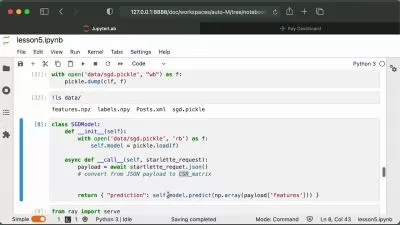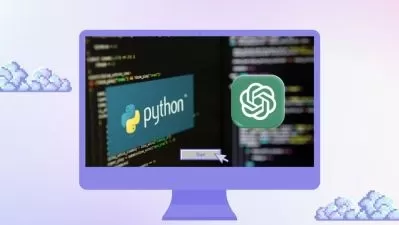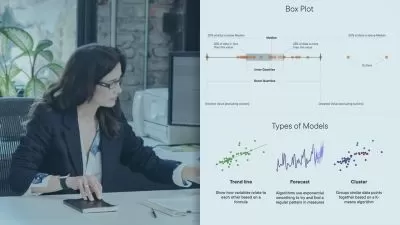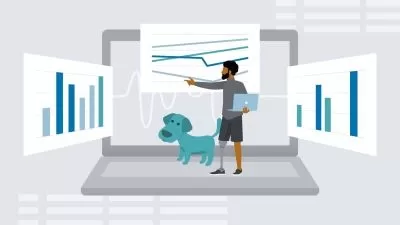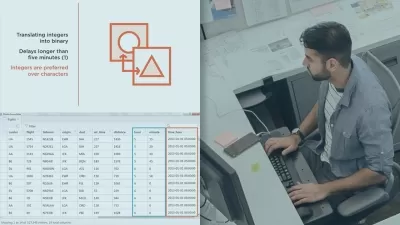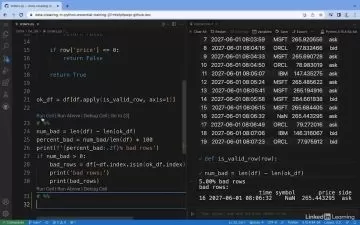01.01-course introduction.mp4
01:37
01.02-course structure.mp4
02:08
01.03-is this course right for you.mp4
00:56
02.01-introducing data preparation.mp4
01:43
02.02-the machine learning process.mp4
03:07
02.03-data preparation defined.mp4
02:19
02.04-choosing a data preparation technique.mp4
01:37
02.05-what is data in machine learning.mp4
02:49
02.06-raw data.mp4
04:44
02.07-machine learning is mostly data preparation.mp4
02:28
02.08-common data preparation tasks-data cleansing.mp4
02:21
02.09-common data preparation tasks-feature selection.mp4
02:09
02.10-common data preparation tasks-data transforms.mp4
02:26
02.11-common data preparation tasks-feature engineering.mp4
01:14
02.12-common data preparation tasks-dimensionality reduction.mp4
01:49
02.13-data leakage.mp4
00:42
02.14-problem with naive data preparation.mp4
03:10
02.15-case study data leakage train test split naive approach.mp4
02:19
02.16-case study data leakage train test split correct approach.mp4
01:26
02.17-case study data leakage k-fold naive approach.mp4
02:37
02.18-case study data leakage k-fold correct approach.mp4
01:58
03.01-data cleansing overview.mp4
01:17
03.02-identify columns that contain a single value.mp4
01:56
03.03-identify columns with few values.mp4
02:26
03.04-remove columns with low variance.mp4
02:06
03.05-identify and remove rows that contain duplicate data.mp4
02:16
03.06-defining outliers.mp4
01:30
03.07-remove outliers-the standard deviation approach.mp4
03:13
03.08-remove outliers-the iqr approach.mp4
02:33
03.09-automatic outlier detection.mp4
03:04
03.10-mark missing values.mp4
03:59
03.11-remove rows with missing values.mp4
01:29
03.12-statistical imputation.mp4
01:12
03.13-mean value imputation.mp4
02:47
03.14-simple imputer with model evaluation.mp4
01:12
03.15-compare different statistical imputation strategies.mp4
01:30
03.16-k-nearest neighbors imputation.mp4
03:00
03.17-knnimputer and model evaluation.mp4
01:58
03.18-iterative imputation.mp4
02:24
03.19-iterativeimputer and model evaluation.mp4
00:55
03.20-iterativeimputer and different imputation order.mp4
01:17
04.01-feature selection introduction.mp4
01:27
04.02-feature selection defined.mp4
02:31
04.03-statistics for feature selection.mp4
01:47
04.04-loading a categorical dataset.mp4
01:52
04.05-encode the dataset for modelling.mp4
01:45
04.06-chi-squared.mp4
01:48
04.07-mutual information.mp4
01:22
04.08-modeling with selected categorical features.mp4
02:19
04.09-feature selection with anova on numerical input.mp4
03:44
04.10-feature selection with mutual information.mp4
01:37
04.11-modeling with selected numerical features.mp4
01:27
04.12-tuning a number of selected features.mp4
02:28
04.13-select features for numerical output.mp4
01:56
04.14-linear correlation with correlation statistics.mp4
01:55
04.15-linear correlation with mutual information.mp4
01:46
04.16-baseline and model built using correlation.mp4
01:51
04.17-model built using mutual information features.mp4
00:38
04.18-tuning number of selected features.mp4
03:00
04.19-recursive feature elimination.mp4
02:19
04.20-rfe for classification.mp4
02:40
04.21-rfe for regression.mp4
01:28
04.22-rfe hyperparameters.mp4
02:02
04.23-feature ranking for rfe.mp4
01:46
04.24-feature importance scores defined.mp4
02:12
04.25-feature importance scores linear regression.mp4
02:22
04.26-feature importance scores logistic regression and cart.mp4
02:27
04.27-feature importance scores random forests.mp4
01:07
04.28-permutation feature importance.mp4
01:49
04.29-feature selection with importance.mp4
02:18
05.01-scale numerical data.mp4
01:44
05.02-diabetes dataset for scaling.mp4
01:23
05.03-minmaxscaler transform.mp4
01:23
05.04-standardscaler transform.mp4
01:32
05.05-robust scaling data.mp4
03:10
05.06-robust scaler applied to dataset.mp4
01:15
05.07-explore robust scaler range.mp4
01:04
05.08-nominal and ordinal variables.mp4
02:30
05.09-ordinal encoding.mp4
02:00
05.10-one-hot encoding defined.mp4
00:56
05.11-one-hot encoding.mp4
01:46
05.12-dummy variable encoding.mp4
01:44
05.13-ordinal encoder transform on breast cancer dataset.mp4
02:50
05.14-make distributions more gaussian.mp4
01:46
05.15-power transform on contrived dataset.mp4
02:05
05.16-power transform on sonar dataset.mp4
01:41
05.17-box-cox on sonar dataset.mp4
01:45
05.18-yeo-johnson on sonar dataset.mp4
01:28
05.19-polynomial features.mp4
03:02
05.20-effect of polynomial degrees.mp4
01:35
06.01-transforming different data types.mp4
01:50
06.02-the columntransformer.mp4
01:50
06.03-the columntransformer on abalone dataset.mp4
02:09
06.04-manually transform target variable.mp4
01:59
06.05-automatically transform target variable.mp4
03:10
06.06-challenge of preparing new data for a model.mp4
02:50
06.07-save model and data scaler.mp4
02:11
06.08-load and apply saved scalers.mp4
01:08
07.01-curse of dimensionality.mp4
01:31
07.02-techniques for dimensionality reduction.mp4
02:53
07.03-linear discriminant analysis.mp4
01:44
07.04-linear discriminant analysis demonstrated.mp4
03:03
07.05-principal component analysis.mp4
03:56
9781803239040 Code.zip








